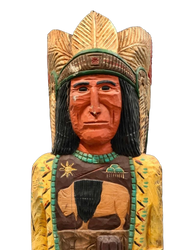History of the Cigar Store Indian
Posted by Jim Olson on Sep 30th 2025
Long before neon signs, flashy logos, or a social media post, shopkeepers had to be creative when it came to catching a potential customer’s eye. And if you were selling tobacco products, there was one unmistakable sight that said it all — a carved wooden Indian figure, standing stoic on the sidewalk. Beckoning without saying a word. This iconic piece of commercial folk art, traditionally known as a “Cigar Store Indian” and today often referred to as a “Carved Native American Figure,” has an interesting history.
Trade Roots
The story starts in the 17th-century. Not long after European traders were introduced to tobacco by Native Americans, tobacco became a sought-after commodity in Europe and early tobacconists looked for a way to let potential customers know what they were selling. This was a time when literacy was low and signage was largely symbolic (think of a striped barber’s pole). Now enter the carved Native American figure to represent tobacco, usually posed with a clutch of cigars in hand. These carved wooden figures acted as a visual representation of the origin of the product. Kind of a nod to the folk who introduced tobacco to the world.
Interestingly, many of the early carvings produced in Europe were not very accurate since most woodcarvers there had never actually seen a Native American before. Still, the public got the message: Native American tobacco sold here.
Adopted and Refined in America
By the mid-1800s, as American towns and cities grew, the cigar industry was also booming. These carved figures became a common fixture on the streets of America as well. If you were walking through a downtown during that era, chances are you’d spot one standing proudly outside a tobacco shop.
Many of the craftsmen back then who carved these figures were former ship carvers who once decorated sailing vessels with intricate figureheads and ornamentation. But as the maritime industry shifted to iron-hulled ships, their skills were redirected towards things such as commercial signage, and cigar store Indians became one of their most visible outlets.
It wasn’t just Native American figures either. You might see soldiers in uniform or fashionable ladies dressed up, all of which were intended to convey a product message, atmosphere, or certain appeal. Still, the image of the stoic Native American holding a cigar or tobacco bundle remained the most iconic of them all.
Carved Billboards on the Sidewalk
These figures were larger than life in more than one sense of the word. Most stood anywhere from four feet to over ten feet tall and were often brightly painted. Some had smoking pipes or wore elaborate beadwork and headdresses, while others were simplified silhouettes meant to be seen from a distance. But most weren’t just advertisements, they were hand-crafted street sculptures, often personalized, and designed to halt people in their tracks. In a way, they were the original form of “branding” for a business.
Decline in the 20th Century
As the 19th century gave way to the 20th, times were changing. City ordinances began to crack down on obstructions on sidewalks. And with rising literacy, shopkeepers started relying on printed signs more than visual ones. Add the increased cost of labor and throw in war-time scrap drives, and it’s no surprise that many of these figures disappeared from view. While some were repurposed, others were stored in basements or old barns. But thankfully a number of them survived — rescued by collectors and historians who saw the value in preserving them. Today, many survive in museums, antique shops, and private collections.
A Complicated Legacy
Like many objects from the past, the cigar store Indian figure has a complicated legacy. On one hand, it’s a reminder of skilled craftsmanship and a time when advertising was literally carved by hand. But to some it’s a reflection of how stereotypical Native American imagery was used to sell tobacco products. That said, these figures do remain valuable to many as pieces of folk art. They speak of a different time — a time when folks thought differently than today. They remind us of the entrepreneurial spirit of early America and of the craftsmen who adapted and thrived in that era. It was a time when a single carving on a sidewalk could communicate more than words: Native American tobacco sold here.
For the Collector
These figure are now much more than old store signage. Today they are artifacts of American commerce and culture. If you are fortunate enough to come across one of the originals — whether at an estate sale, auction, or tucked away in an old trading post somewhere — do your homework. The age, condition, size, craftsmanship, and especially provenance will all affect its value. Earlier figures dating to the 1800s with original paint, documented history, or a known carver can command high prices. But even later reproductions have a strong collector interest — particularly if the carving has a bold personality or is made by a well-known carver (or family of carvers).
Whether displayed in a personal collection or thoughtfully preserved in a museum setting, the cigar store Native American figure is more than just a throwback to an old piece of advertising — it’s an important chapter of American commerce and folk art history.
Jim Olson © 2025

